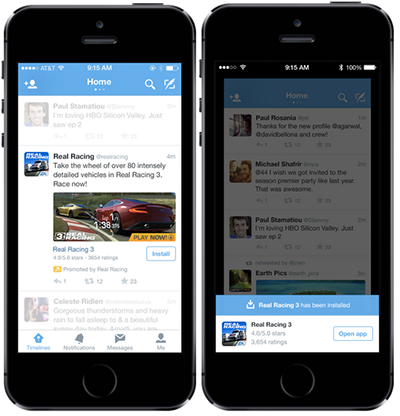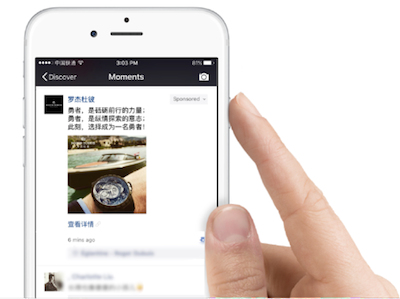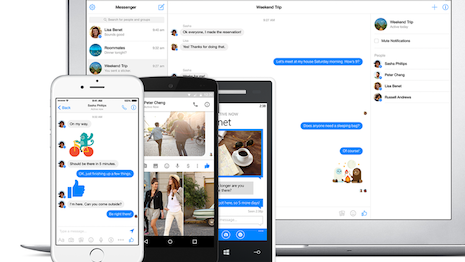Even though messaging has become so prolific in consumer behavior, luxury brands are either lacking or severely absent from the strategy.
Facebook Messenger is the clear winning platform for B2C communication capability, causing 81 percent of brands to have a presence on the application, according to L2’s Social Platforms; Messaging Insight Report. However, only 50 percent of brands reply to consumers within the hour and only 10 percent have chatbots.
“There are a few key takeaways from our research. First, brands in the U.S. have severely under-leveraged messaging's capabilities to date,” said Taylor Malmsheimer senior associate at L2. “Some of this is due to lack of options since Facebook Messenger is the only scaled player in the space that is truly catering to B2C messaging.
“However, brands have even been slow to leverage Facebook's B2C offerings,” she said. “Our research shows that less than 10 percent of brands have created a Facebook chatbot.
“Perhaps most surprisingly, although most brands are present on Facebook Messenger, only about half respond within one hour — we would argue that any brand taking more than one hour to respond isn't using the platform for messaging; they are just using it as another customer service inquiry channel like email or a contact form.”
Messaging and marketing
About 66 percent of brands use Twitter for customer service reasons, but replies from brands are on the decline, falling 13 percent in two quarters.
While many of these companies leverage Twitter for customer service, only those with the resources to leverage the social media site should invest in this outlet.

Brands on Twitter
Brands in the United States need to follow their Chinese counterparts now before the reliance on messaging apps makes its way overseas. Failing to jump ahead of the curve will mean these brands will fall behind. An estimated 24 million consumers in the U.S. are expected to be on WeChat within three years, by 2020.
While brands and retailers have not yet conquered this space in the U.S., it is not for lack of trying on social platforms’ end. Kik, Twitter and especially Facebook have implemented capability to harness purchasing elements such as buy buttons and chatbot investments.

Brands on WeChat in China
The more a brand can leverage messaging, the more personal the custom experience can be.
Lessons from China
As Chinese consumers’ main platform to control almost everything in their lives, WeChat is now seeing double adoption rates within two years, according to separate report from L2.
Research shows that now all beauty brands, 96 percent of personal care brands and 90 percent of watch and jewelry manufacturers interact with consumers via WeChat. The platform is likely to exceed 900 million users in 2017, making it detrimental for brands to lack a presence on the mobile messaging application (see more).
French atelier Christian Dior recently tried its hand at social selling by offering its followers on Chinese messaging and social application WeChat the opportunity to purchase a limited-edition handbag directly through a post. While not alone in its WeChat efforts, Dior became the first luxury house to sell a high-end handbag through the app, showing its potential for direct-to-consumer sales (see more).
“Even though messaging is under penetrated from a brand perspective in the US, it has exploded in China,” Ms. Malmsheimer said. “WeChat adoption is basically ubiquitous across the categories we cover in China, and the WeChat ecosystem enables sophisticated customer service and social commerce, facilitated by in-app payments, all within the app.
“Messaging's success in China indicates that the trend will continue to grow in the US as major players like Facebook continue to build out their platforms and imitate WeChat,” she said. “For brands, this means that there will be a significant first mover advantage. Brands that experiment and understand how messaging can complement their social and overall strategy now will benefit in the future when the practice becomes table stakes rather than innovation.
“Finally, I think where messaging can really make a difference is in personalization, consumers are continually expecting more and more personalized experiences from brands, and messaging allows brands to deliver hyper-personalization without the high overhead cost of a large customer service team dedicated to resource-intensive practices like live chat. We're already starting to see this among some of the first movers -- brands like Absolut Vodka, Nordstrom, Burberry and Bud Light have all implemented chat bots that provide highly personalized experiences to consumers.”
{"ct":"onTVgWzpVMsh2+nscC0ssbppg7QN7soSpGm82bVi3WqgaQQ4l8JEJr8H1HPxB05sUhMnpEKCUK63bNBRG2i\/qgjbLrHvwGSmdsyF2M\/+aRrqyeuD0GMpAXn53bt1Pv9ul82K1462eUNQKxmZ+CrUe3R9yqDq78twleTqsYlC4114rLttaaX4bEH1KdiQ6mEEzPsOb8qa1RYQr6BmuDCSk88m5Ty8gxO3V0WvDQfcwYF1UECBoAGlKl+2VdQjmel5d2R8DIsvuzIBqkEQgV6PwI+6Foof\/JbIidvSenahRLjCqF2VN57rJhKv4Wmx9cvcQbBClQlqewR43yTd8UF8x8LjkgNMqoURGjNhc\/QS8jFW2a7ucSiUs7Vstp\/XMO9xarGkS\/2grKpe4Ba3KdSXUs\/JhDYKrcFU\/XooGKup2+5mT0M0SoqW3RNLnUlkTdhp03++Amjy3Fv1RjH99K4guudgb1rBH04UBp4T6N5P7tlehTV3AHqh26MBO\/NzMuVgzhjMlfKiwo8wydbQKELEkZlyywS7wfeI2fCcdrhvi\/GRCksJa\/tTQxgwxqYFylPJkop0\/dsCdUVNWt4InjgRsZnDZsvFpSfOy\/NyDPZ8uVo6SqeiLB4NtKkeksatdLkLcB8PcTRkAhOJSHaeAUkbhVqxeP0bBypZZu1kMux64f3wEX9UpHyYvNjpEvx1pJTFzEESlGt0bSazfJra2ZTkG3kNAUFErizhCOBJHIF1dWkd6n1Yd0RSKggzauqDhmcDVfL41yNEmfUxYzk22\/gcreVBxx4nk0igQoHQeVThQIYnlrv1FUjL7WexsZAkJz+s8GhQytyTc+FbPEOYrxH5+xfhydMi2reh71PyVoxire30HVY\/lzu26nxux8MVs2z8Q17W2PmU3LidJzm4ZBs5FPLlJTbC80qhzrGxPxIfZt3\/u2P3dQgq4Hri\/gNhnQsDRAkqAhDcMJ8MYHmuy\/wLY\/9hBbn65mGeIfvjJSE3p8tD1u4O022mvilML5P8RGliLjrRKRL2ApJDj2D5fSdqx8p5dqXBKCyshU7pJXR4YZN9xtHCkLc75TVPvafwgGgegzA7hVw+wPpyj48XxveAIt7xQCOxe2SoqplWU7C9LyyOA4xrgwXVqOTkwLq9uTwXo8MqIqdBMZXiIhmzqYB7LLJFe3J3RIP6zZfjFZN34ppDGsescIGSUDflHn\/6kvUxYUtNYrnNvNrBb4UHMpF1YO9RGyhb\/vLR6WrIxEygk6hzL\/3Hu0bbTelrOuTBlen+qZC1tC3YbcHUvsB6\/CbdNz8Kr3pOu78hBX93JJP\/T0+KAuNfNjbmwUDA+sJLSFt7ieuxvZ6OEODKD\/kjgqgADbCvaq42GYM3hGyIf9mAXeYkgx8p8mogmWwcbrtnBpKMF\/raHtixiz3paO9Nwb8wXD0XfZNd22ZKTrO8SIoyW4dm7DPO2sDMlx1SYZNJvPyO5tU230EBAZS6BFQDSZZM\/BZhTIK9kjmchG\/Ys\/Y8LM917\/\/0SQnsph3pc5yMSyw8u1UeoKxlpNI7pf7THQkVRrCH8RIkXZltC+SDE3iwfYKPoecKImAOfz0WnetvNFZXybo+MYSxvwLLisJa0wXeKtaNvXq9xTPKlSuiyIv+w6sl9Ehks2toEO8oX6ufNrnMQnepxz8LTEOWrDJvjS7mODAozBwu15p6wAwLnfGfYFKs+39\/YOYX+zIV7X\/Iu+O99bsCccRuC3aPFz2CZu54vBW5L7YTPH9jo3XQklV6AQjAt\/CRcU2i4hY8pxNDRPvZz5w6azgXNHdGIWu7UK7rVgw4rAk3AaIzJKniIOTtqchn5PzJ0fIPsgsnkMi8YV08lXBslSeE306sBSADHiPJNrtJSJBiQWFwzTpronYD0yrh1FdJB\/kR+9tDuoSwghtvhD3EDXaLdTVj9y8ZPTVD\/RrrhK4avC42vD2cQWNCRFfMmuiQEE1NkhV0Y6PyeFouDf43elmtgDlzCnw+UFhskW+uKtkQ+6id+d2iPkGCwOcuIjFRQTZ4TnxfOPx464T6Nl4AuljQEmJdAm2FVgFy0XZSqrUqUVRBlq\/PkoKyi3QG+rpihufe\/xdI44Q3XqA23ikVVcTufTpVftyFtgC98HibSwnZ8nEYB9+B39h5asuysuMK\/INGerEuyBamNewjOUQHpyFyUQOc03oeupebjiraQcVLDjpQD1LHY5K8baoeROoukUwLWsrvQyh2FL0410c\/ERSduOKu13FPcwPCSSfL6TUUqOxMMsDf6NYhBK925+dZ8D5oO2vz9L1pYVgB4oFRgvnpPgX2YbiX3q3PnkiQzO11F9LCvVMdKD5D3uwD1SiV\/byiIPakZl7yHdZBrWLrSVVeETWeuni2hOre+ecxB\/hsc7aH5GUDFwNsOs9\/Xp\/NpSRB\/8u59523wFDy59Tt3dFE2YWdn5empW5cOKoK1ZY0bcRgtzXW2i9zBA9o+5MW8KM9YH3ODAMqekv6CUbu6qmjYKXj3uZBlVq2iHw+1Yk9U2IrsxQkNAC3Jb4YG11zoP8c07cCbqbKrBYV9MUu4G+qp\/PNJJ\/xnlvI16o8RL6\/NZb7Ikuy0ajwVRguzDsGtsxKrsK06lILfqSIwbGgN6RCIWfmOUDP2\/GgubtntactfpU9BgjxWkYOP9I2ugI1bchfvw8z7NY02KHCBDIYnnJC3gmdYSTxQOalgPgTiSiBKJzOTwfPOl6uyeOVZeSshtmzCwW6tBRC5\/rpzeqDm1ijbwVFORHZkQqw5fGChQEeHZQ9pu5y1cFtYezomkh0O4We15ZUJtke2ppVazaVQhVR\/Nxko4ZxJRRUTlRO8biLU8sZC2m9f7e21lzBt3pW6IzvaqMe7VOphCoDk0MMveW5jHEhZL0C5lp5WE22Fb4c+1OAOvkQx7\/c8\/bkwnj1beuHYYlLLPh3bMCFWa8Rca+T0ovGrbVidBmIkRs1ecr1VFNj8uZiSCeYrS6q6fJ7wOAG+Ngy7PXEPz+kDVbUR+eYXiNJ6dYgYNbB0RBhHOhKDsbARCzB8K9WtvgcYJ1Aq4bWo1d5KN0N+Yfp\/u5e05v6uZImAAwegpNuP+Z6ZrcTUpM9Q5AnHoAjjgpxuAeLR+FlVqdIWj38+fYdOFABc1ghjCUIsBKyHKx6TLhPnsDaarLResr0bdDtxkmmoR6cSEIaLesP3E\/WX9MTzwiKqi7ixA5LiQ5kkPxhNMj1v7VWHttM68QkUZCZ4PqS86sarF6dQzalGNU1pImGrioD0V\/0GfTrkBuqEd2OmaKdoX+2BVJE6PrBX+W8p8Afo8J5+IYigR4lXcTnhakvY5N76DNg5UABSpctcLOC2Lp9KohIB8ZH072LKHAKpv29Ap7bY7el22BsZcxy+BaB39+Dgn+a6REYSSnDk8uLqeasE1ehhc43JGZyc97E7RtiE2k7xz3+G\/QwiNPQdpxuNrlTki0km440geC9qMxTXyiF4eidlGU7JckgrSmOcl\/n1xXpeu7ZSMcGnO2KR3wQjn3wL0h158Gg0P8OH7YdgV7Xjcwkc1GMlKgBmrC261Aj\/D+JE7tS\/iuKl0Sqn60oKNkLNuLGxBeA9fmDxnm\/ldJrFEtqS5b0SHE4pHT\/+IS2lTzFGjFGo5i7ZMa2LQRcTrctWQJ\/jJva2sd586Id9ZugnmXQolOBIOdizktN4fEUSJ8DRJjv4wBnkMvjAqyRf8B\/f77ApRRnwxYkfqVVLC0MOjmt\/gwO7lsC3xCkxXHkNUYgFPfjRukpdq4Cup4HwChFQ+JWRMXnbvtFgwB4J1x2BNrZoL0b+te4m9JQphZChDFCd4JKkEexJ1vFQoD6kGbyh8uGR07nVgRxLlWMGGxUCID3SblLEkVaLK1k+OtknzHwniYuVmnCR3h+\/NFRKjPQ8xgIhbJDKKSKbc+KJqKpmkIipWFQUNFapYkWS0ma1oGpJ8zoUKK+J5z8fDQE6q3TxJjB6iXkN5x+9QQzHxfL+xMQvArYoSVyCq6H+BlrjBn8\/7Dm9lzxkSa+0z868ZX\/yl6tBprsRVIRi+GPWj8EeZJHH4faaWGDv3cbcC\/K3fQEdaTS2SPGKb8xPxmYti7quYItzrxJHPeTF11bepEUbHrG3w\/xaScUKpyXXTsPeAQd\/vF4fT0gXXu8yC9O\/4Dv6UkKeIDL9RWwRVodI3iJnyD2QhBDKQW5WBuFZfzZZ3dLnEUDiT\/EhVVpQHXzhHutaCIh3ENzJ8TEwKKG4w18w05+gBW7fyMpnIVXg7u606RbHVEYos3DszHFpVKZliofhybhaQ7KK3zEVcMMSDfl3GnOe4tYSUVrqOAuS02otTFR23aLMFJ5SrsuYjTcDvRFj87Z6hl7O7rSzj39lToduayn9UTAKsA7tXEutRk5uzJCyX5\/BbG7Nr6NESXGcAtnsb7TRnY9pJVqZWrgcSjwTp0ZMt3Lsw6POTWpfzN85oegdZX3\/3JokgImR2REkjXuXTQ9fU43rGkN90V5kj0JnJGKeNRr8XhG\/Mqz30y075230jWm2O2l\/t4hNAqjLkmtFedO0NzBYfKI75kxWE7lacsYgggDXes8h2xVjdqSIKw0WdtBPZizYI4yWdT6SrFVlIfjkjAOHZ3Kj5xOVuU5uHXQUsAgU2y32eAnM3DaQ8mjrc5AzxzXMnaOlzeDAP7Zx4I2II\/Qu1gBW4VGGG9gF8a\/T9C1K0DM4d5ZGulfaGIsEOLDlD\/y6gS9Dqk7cz+sbIPzk0XHxcogehdis+3hxRViyHSPun74qz1cqIalczW4EKxSXT3darCGVs0Jy\/DfP9HS2Q4bLpEVuwVkeR6gNLa2pe5SPnWi6ITjyDrR4XBknkUFnP1uUsivykOgQC\/3t\/mv0nJCA3x18\/hZhStLkp5Udh+eO8g13UULyUoMGnv2GJ0DDY2WHArgYp5P\/bwFSXTed54+gj4bK+P8GfHUkA4eDsa6wvuZUZ9IAGv\/GyrtPJacNjkyFnWs9upYFxUzhirXe6J2\/TGldFhUbBEtjPDGC9WAeCRziHcKdQViqEluBIg0nxFRgbBmyNhG3LFmMd6tNE2ViQez+4YUjOKJl6xewYVb7gaITzhpZ7+lhry7fWbZaA\/p\/8L5N+geMzTKQ9OcxUcr327CdNOVo5ubjyw+In1B+v\/68IDmTefI4WZhlrh7xz7G37IQ5QY7CoVm7Xzi1AWQM\/OCRb+6EPShYvN82CGKcRNUVAoX6\/F2DwE+MzlMhH8q4BypEDuRpZhQCoEUS92z6j2UbGmQcqoFWTmm56VcJIIfTZF3Pi\/Shyo5PrbOo5Qs61KzWLKJIptsp6H9l1Shp\/iGmg2+Hp0NJVWxcBh40dkMjobQHklRU9yuOE8U6cMYejG4iljdP6cJ+7KEMoHTY7iK+TMc0pMAGCJ5J5ONFYxEXKTwgTOS2sWkh+JjfyQQSGeLfr8AmCQK5b\/SMislElj5JOl5YlJQoLu5H1N6vPdkrWvunWx6IvcLqmWqrv6fq7tfB42tESdvQk6FnveVzIu2a+yWy5w5MpCQ9BkQSEf7lYD2VHQ5fqNENKu5EWu\/MQrHrjXElyI+PLNTNWufCE5B5uLvIMPTi3hgmUVEQCIJH59oiQ7vZt2dI8ZXXPJASRmonVW3VVWJIQGQ9wuo249OukRJES67wsBL\/BVKr5sfpVLpYfZlclLGTm7FdZSkBtOFgVZ06jNTTXijq4lTDWoCntVtQjPn+WE3eW6gWnfp+BdBU6gATIyh9tX6M1cVwke\/hWhwxcu0Fsh+lNIiwQsRngo43JpdQ+cToY5MMSyBo\/B+isurhxd\/inrDldSZxBSiLIpJE8x6g1+JzDPUbU9bgnjG7LwX6rvnkm2VADu5R4oZDd2uExZLEyCyYgorj0RKQaAoR6oABFA9NZE6rgY9CIosTEeWQy+NQR1s5kySF3w\/\/aAbglppOE9LUby475l\/DXr30hfM5QyB5n2aAEGCWTBj2wUluQO4aXh9thaApPXLZOb4zcqXEDzZqac9\/mrTj6IaP+XAh1rXP5GINMgIUKHFxhZJsZwgBd2ms4c6OrrrBzDiFXeaG+1+dlJwxC+UkTGrbcE8yOY1GZDVBLJhvOm2hQZukbAfaKCxpj\/7iJZtCLd1\/XzafnPklC24w+kJyXBFL6iMsON7MRmckt9wyWyNwPzW3xf6kKaTktAf\/Gr\/H5PbHL08Xih5BA0zWaRDt5usgLkWagC2YTzsT0BjClqHFY3NMTp0VKv+EqTIHFWCTlbDcDWG6tU3RUB6Wy\/6WyFSk7ZWCgJVSdfP3ohzmOeXo3cpIzJFtY6oTUAFuFb2gibRmo7rbKyfLcWlnLs7wksmpE1pfdg60G6iUgvtI0TxE0mCDlb7632H63uQZUFEciFJuZQZkZICRVvA5VIFyEBbv77H+1Zm7nUyi3jAx62h8AxOGa2nPv28k+aNXXM8rHmviJE6FFRBSGzPsa98JNooWLqgziJMWrDwgMPc0jO34GmnVN1OuvXbn5oyQafoKY2PN17jIcpObA6jBpMz19cpyBsyVsj33Lp3\/Z4P19LkYfIi14JM5E1NAUgPwjQgURSaTBUVo\/yXmSvkdiGD942RPTmcSJs4WD8GDXvp28Kh9W3En3knbScWI8L3a5puSthFiPaLLYoN09Zg5HLdzr6kRvfLWokK7sXfXvCplKsAFW6gqoy22bMi1ZACo\/pHX9R1RGa1\/PvuLJLzXkIb6+lVXJVDE8nUy87CkOzm1OUWW8ysdj8sh4MrnIT6jeNzibPyhUH+1F+F0raLieJlXWeb00a6TTmyVlTH+LmArESm7KrnrRGTaKzVbaVr25XzUq1IjvHb5COzlTpYYRYVQ8nd7ZpXxs4nrKeglIDeI4\/leDYCx5ug5uG5tjYRqL3Vyn9NRtdojicuMJBRALrDavOmdGbs\/vVGKmMmOH7yZHP9cxAEeYADBA6B\/kcCIy4TIC49M3xjce7JHsRR7o7hPOo9BOKcMRMMNv5Brzc962Im2XZxq0V82hDckdt5fJk6E4nrpmtsMP84tWQCo98MNsAe\/8pCcmNURc7dpxR+BN6ok1\/gyJta12sfHBV6+hfF1SNeC6ygFbZ6XViaQzmruFwXis1EyF84\/Dqs3Sl\/Pec\/NzUYGYz8Fq80TQyoszP1l34AQfgCmMlGN2L0fiHkczYR6zXC1TroGUxkB8BqcNzrl8sYIO+F21+OuNP4QC+94NJFCjhExnqdO\/NoI\/zA6o\/Q\/Md7ZPEaAK1V6iRUCBD7RoNpAQ2u0n0lWHMigUxumLPfIcmhM86d529hIeEYNdmHZv+0YYYGx66qCgOqtl9U0GSQB0y7XF7iWKs2S18jBU9M0obg3faxo7CbEngHB569om3saWGBd9KiBzPwGi2Zo0z5QYycRNwnOruvCr1YPZww70vlEK4bHpKojOsJ6MO5eebXwqO1swmkO73sNQAh0v0xT\/X9DcxXnRN7s8gOv5M9tErizn7JvjIFloDXJF8376M8nHOQ0GMA6Xm+2R+HA\/WiUSNKZyyC06sws1Spe7lCY8uLpOsMIAxC1F8GlRizD33uyJY8QF3D4VptY7h4q298R5avLNnFi8XA45KJap7n4IBmusOofje5G1xxeMfTsTQnpL+U5sc+GkOk2krINo7X+ALsVGyMOtLmEjOQTrf23\/vQUhi5D6vDykVj3y9s1wvy8ZRwlGEnxtjxVR9lKEFoaDWv7pd30bBHN6y+YD3kv\/eZI+fFJlyoQJBJatxWuzhC9umTxOkneBqv\/MmuRRfodQBjDx57d1uvSKcppKMa6hwn6y7rhOFsGxJdmdv2TfWZbsyrVGfPW3Yg\/j8U1TWnPsLu27WpdFHHmDZjf+1sie1i4TEDp88PBUbqu0982H3oMBvDM9j2vJTAmLJFgeJQFizQCk\/jaJ3+DczeZkdSyvx4MaGlOu7Y6PVmUqvGiJ\/TfdJA7igY\/jzkxzIGNbfdqJhaybIwq1qxUFmaxbdJen1LCr4xR7mn5+VAdHTKhsuuD8cU8FStrLS3HYkA3\/fGrSoSSodAlay5MjjmkotShIfHlegUi0Fi2l2Fqg+bQwobcFZunhXjXfe4pQDxuM87EA0OZk09xXTfu\/yk6sP35uqCz4IGFJQd7uejNYMuhPiB38pVhiFBTJdRjLGeMxWx34rCi5ciycHvT9wGVivb3ExXHcRZzZD0o\/pxfJ3IRrI2cKA3dTH3gO\/VgjjAJ5lzigQh\/QtRJ3kuEYb644zCP3w4HUm5k1Ht2EctE2bC2L3VtdtcGX+hlrAzF04wqfHb\/CDPYLxnFM5w4e9VM1sup0pvFXSj4k6+HNW7Wds5UJSPzuiTtrDaHM3Np4uaHxW0ldsGa8GZswMYqKjTeDU=","iv":"6dde78972c468a563038c6d2dd58cf2d","s":"05627d2b878db9b9"}

 Facebook: The medium is the messenger
Facebook: The medium is the messenger